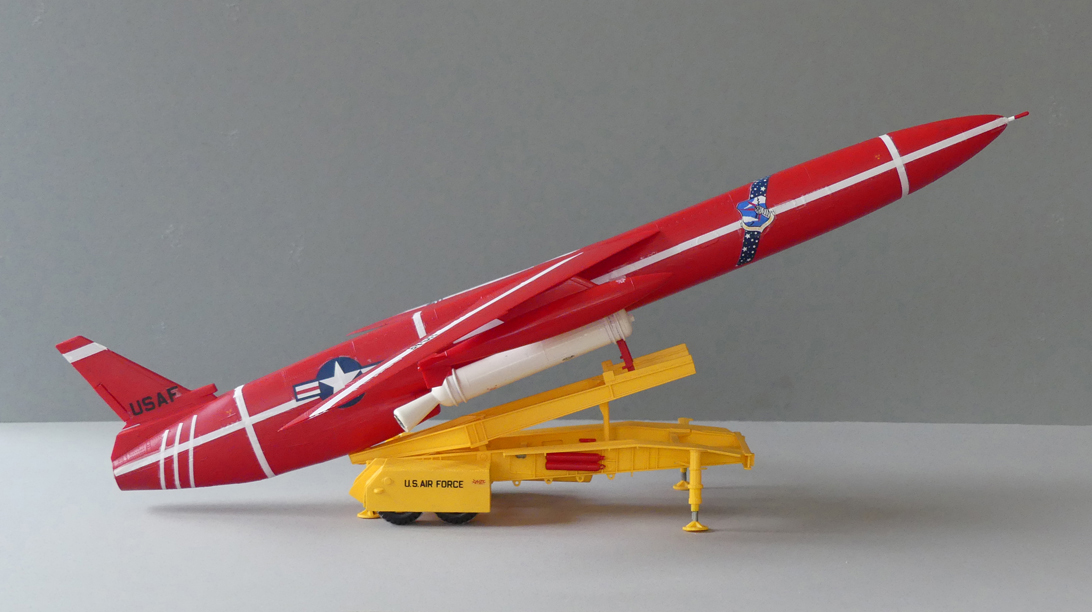

The Snark, a pilotless nuclear missile, represented an important step in weapons technology during the Cold War. It was named by Jack Northrop and took its name from the author Lewis Carroll's character the "snark". The SM-62 (Strategic Missile) program lasted from 1945-1961, and it gave the U.S. Air Force valuable experience in developing long-range strategic nuclear missile systems. The SM-62 was a significant forerunner of cruise missiles developed many years later.
In 1945 the U.S. Army Air Forces asked for proposals for a pilotless bomber that could deliver a 2,000-pound conventional (later nuclear) warhead. Northrop Aviation proposed the Snark design, an early and ambitious example of an intercontinental-range cruise missile. Guidance of the vehicle to the target proved to be the biggest technical challenge for the missile technology of the 1950s. To solve the problem, the near-supersonic Snark used an innovative guidance system that relied on inertial navigation updated and corrected by star tracking.
Development of intercontinental ballistic missiles (ICBMs) and newer, faster manned jet bombers complicated the SM-62's prospects. However, the Snark concept remained attractive because it was cheaper than ICBMs, and unlike bombers, did not risk aircrews, needed no tanker fleet for air refueling, and was easier to maintain. Guidance and aerodynamic issues, though, slowed the SM-62's progress, even as design variations made the Snark bigger, faster and able to deliver more powerful nuclear warheads.
While several test Snarks were launched from fixed platforms, operational missiles were to be launched from mobile platforms. At launch, solid rocket motors helped the Snark quickly gain speed, then dropped away as its jet engine took over. When the Snark approached its target, the nose separated, and the nuclear warhead inside continued on a ballistic path to the target.
The USAF placed its first Snark on alert in March 1960 with the 702nd Strategic Missile Wing (SMW), Presque Isle Air Force Base, Maine. Soon after, however, the USAF withdrew the missile from service. In June 1961 the 702nd SMW was inactivated after President John F. Kennedy declared Snark obsolete compared to the newest nuclear ballistic missiles and manned bombers.
Facts and General Characteristics of the SM-62 Snark Missile:
Manufacturer: Northrop Corporation
Length: 67 ft. 2 in. (20.47 m)
Height: 15 ft. (4.6m)
Wing Span: 42 ft. 3 in. (12.88 m)
Weight: 48,150 pounds (21,840 kg) without boosters; 60,000 pounds (27,000 kg) with boosters
Engines: Pratt & Whitney J57-P-1 jet engine of 10,500 lbs. thrust and two Aerojet-General solid-propellant booster rockets of 130,000 lbs. thrust each
Guidance: Doppler radar (at launch), celestial and back-up Doppler (midcourse), ballistic (terminal phase)
Range: 6,300 miles (10,200 km)
Ceiling: 50,250 ft. (15,320 m)
Maximum Speed: 650 mph (1,046 km/h)
Warhead: W39 thermonuclear warhead (explosive yield: 3.8 megatons)
Facts and General Characteristics of the Model:
Manufacturer: Lindberg Hobbies, Inc., Lake Bluff, Illinois
Scale: 1/48
Parts: 195
Decals (actually used): 54
Missile Length: 17.8 in.
Missile Wingspan: 10.7 in.
Launch Platform Width: 3.5 in.
Launch Platform Length: 7.3 in.
Hours to build and paint (including crew figures): 19.4
Problems/Mistakes:
1. Instructions and illustrations were poor.
2. Many parts did not fit well.
3. Several connecting parts did not have pins and holes.
4. Decals were not numbered and the only guide for where they should be located was the box illustrations. I used actual historic photos but they do not show where any of the tiny decals like “no step”, etc. should go, so I guessed or left them off.
5. White stripe decals were very close together making it difficult to see where to cut them out.





Moving launch platform and missile.

Preparing for launch.

Ready for launch.

Launched!